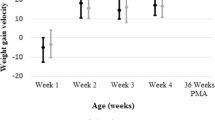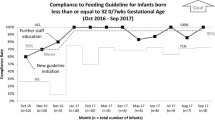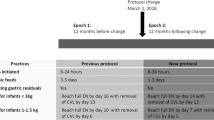Abstract
Objective:
To develop an evidence-based feeding bundle to safely decrease the rate of PNGR in VLBW infants.
Study Design:
The bundle was developed and implemented in January 2010, followed by 3 years of monitoring bundle compliance and infant outcomes (days to first feed (FD), days to reach full feeds (FF), and birth-discharge growth trajectories (delta z-score)).
Results:
Data were collected on 482 infants (119 pre-bundle). PNGR decreased from 35% to 19% (P<0.01) and weight delta z-score improved from −0.82 to –0.45 (P<0.001). Percentage of infants with head circumference (HC) below 10th percentile at discharge decreased from 21% to 9% (P<0.01) and HC delta z-score improved from −0.65 to –0.17 (P<0.001). FD and FF also decreased significantly. Rates of necrotizing enterocolitis, peak alkaline phosphatase and peak direct bilirubin levels all trended downward.
Conclusions:
An evidence-based, standardized feeding bundle was safe and effective in reducing the rate of PNGR and in improving head growth in VLBW infants.
This is a preview of subscription content, access via your institution
Access options
Subscribe to this journal
Receive 12 print issues and online access
$259.00 per year
only $21.58 per issue
Buy this article
- Purchase on Springer Link
- Instant access to full article PDF
Prices may be subject to local taxes which are calculated during checkout




Similar content being viewed by others
References
Ehrenkranz RA, Younes N, Lemons JA, Fanaroff AA, Donovan EF, Wright LL et al. Longitudinal growth of hospitalized very low birth weight infants. Pediatrics 1999; 104 (2 Pt 1): 280–289.
Hay WW Jr, Lucas A, Heird WC, Ziegler E, Levin E, Grave GD et al. Workshop summary: nutrition of the extremely low birth weight infant. Pediatrics 1999; 104 (6): 1360–1368.
American Academy of Pediatrics Committee on Nutrition: nutritional needs of low-birth-weight infants. Pediatrics 1985; 75 (5): 976–986.
Clark RH, Wagner CL, Merritt RJ, Bloom BT, Neu J, Young TE et al. Nutrition in the neonatal intensive care unit: how do we reduce the incidence of extrauterine growth restriction? J Perinatol 2003; 23 (4): 337–344.
Stephens BE, Walden RV, Gargus RA, Tucker R, McKinley L, Mance M et al. First-week protein and energy intakes are associated with 18-month developmental outcomes in extremely low birth weight infants. Pediatrics 2009; 123 (5): 1337–1343.
Franz AR, Pohlandt F, Bode H, Mihatsch WA, Sander S, Kron M et al. Intrauterine, early neonatal, and postdischarge growth and neurodevelopmental outcome at 5.4 years in extremely preterm infants after intensive neonatal nutritional support. Pediatrics 2009; 123 (1): e101–e109.
Ehrenkranz RA, Dusick AM, Vohr BR, Wright LL, Wrage LA, Poole WK . Growth in the neonatal intensive care unit influences neurodevelopmental and growth outcomes of extremely low birth weight infants. Pediatrics 2006; 117 (4): 1253–1261.
Belfort MB, Rifas-Shiman SL, Sullivan T, Collins CT, McPhee AJ, Ryan P et al. Infant growth before and after term: effects on neurodevelopment in preterm infants. Pediatrics 2011; 128 (4): e899–e906.
Patole S . Strategies for prevention of feed intolerance in preterm neonates: a systematic review. J Matern-Fetal Neonatal Med 2005; 18 (1): 67–76.
Dinerstein A, Nieto RM, Solana CL, Perez GP, Otheguy LE, Larguia AM . Early and aggressive nutritional strategy (parenteral and enteral) decreases postnatal growth failure in very low birth weight infants. J Perinatol 2006; 26 (7): 436–442.
Heird WC . The importance of early nutritional management of low-birthweight infants. Pediatrics in Review/American Academy of Pediatrics 1999; 20 (9): e43–e44.
Adamkin DH . Nutrition Management of the Very Low-Birthweight Infant. NeoReviews 2006; 7: c602–c607.
Camelo JS Jr., Martinez FE . Nutritional dilemmas in extremely low birth weight infants and their effects on childhood, adolescence and adulthood. J Pediatr 2005; 81 (1): S33–S42.
Heird WC . Determination of nutritional requirements in preterm infants, with special reference to 'catch-up' growth. Semin Neonatol 2001; 6 (5): 365–375.
Eidelman AI, Schanler RJ . Section on B. Breastfeeding and the use of human milk. Pediatrics 2012; 129 (3): e827–e841.
Cooke RJ . Nutrient requirements in preterm infants. Pediatr Res 2003; 53 (1): 2.
Kuzma-O'Reilly B, Duenas ML, Greecher C, Kimberlin L, Mujsce D, Miller D et al. Evaluation, development, and implementation of potentially better practices in neonatal intensive care nutrition. Pediatrics 2003; 111 (4 Pt 2): e461–e470.
Carroll J, Slobodzian R, Steward DK . Extremely low birthweight infants: issues related to growth. MCN Am J Matern Child Nurs 2005; 30 (5): 312–318; quiz 9–20.
Lemons JA, Bauer CR, Oh W, Korones SB, Papile LA, Stoll BJ et al. Very low birth weight outcomes of the National Institute of Child health and human development neonatal research network, January 1995 through December 1996. NICHD Neonatal Research Network. Pediatrics 2001; 107 (1): E1.
Newell SJ . Enteral feeding of the micropremie. Clin Perinatol 2000; 27 (1): 221–234.
Kennedy KA, Tyson JE, Chamnanvanikij S . Early versus delayed initiation of progressive enteral feedings for parenterally fed low birth weight or preterm infants. Cochrane Database Syst Rev 2000; (2): CD001970.
Kennedy KA, Tyson JE, Chamnanvanakij S . Rapid versus slow rate of advancement of feedings for promoting growth and preventing necrotizing enterocolitis in parenterally fed low-birth-weight infants. Cochrane Database Syst Rev 2000; (2): CD001241.
Kamitsuka MD, Horton MK, Williams MA . The incidence of necrotizing enterocolitis after introducing standardized feeding schedules for infants between 1250 and 2500 grams and less than 35 weeks of gestation. Pediatrics 2000; 105 (2): 379–384.
Donovan R, Puppala B, Angst D, Coyle BW . Outcomes of early nutrition support in extremely low-birth-weight infants. Nutr Clin Pract 2006; 21 (4): 395–400.
Smith JR . Early enteral feeding for the very low birth weight infant: the development and impact of a research-based guideline. Neonatal Netw 2005; 24 (4): 9–19.
Tyson JE, Kennedy KA . Trophic feedings for parenterally fed infants. Cochrane Database Syst Rev 2005; (3): CD000504.
Premji SS, Chessell L, Paes B, Pinelli J, Jacobson K . A matched cohort study of feeding practice guidelines for infants weighing less than 1500g. Advances Neonatal Care 2002; 2 (1): 27–36.
Premji SS, Paes B, Jacobson K, Chessell L . Evidence-based feeding guidelines for very low-birth-weight infants. Advances Neonatal Care 2002; 2 (1): 5–18.
Hanson C, Sundermeier J, Dugick L, Lyden E, Anderson-Berry AL . Implementation, process, and outcomes of nutrition best practices for infants <1500 g. Nutr Clin Pract 2011; 26 (5): 614–624.
Patole SK, de Klerk N . Impact of standardised feeding regimens on incidence of neonatal necrotising enterocolitis: a systematic review and meta-analysis of observational studies. Arch Dis Child 2005; 90 (2): F147–F151.
Lucas A, Brooke OG, Baker BA, Bishop N, Morley R . High alkaline phosphatase activity and growth in preterm neonates. Arch Dis Child 1989; 64 (7): 902–909.
Mitchell SM, Rogers SP, Hicks PD, Hawthorne KM, Parker BR, Abrams SA . High frequencies of elevated alkaline phosphatase activity and rickets exist in extremely low birth weight infants despite current nutritional support. BMC pediatrics 2009; 9: 47.
Lauriti G, Zani A, Aufieri R, Cananzi M, Chiesa PL, Eaton S et al. Incidence, prevention, and treatment of parenteral nutrition-associated cholestasis and intestinal failure-associated liver disease in infants and children: a systematic review. J Parenter Enter Nutr 2014; 38 (1): 70–85.
Tillman EM . Review and clinical update on parenteral nutrition-associated liver disease. Nutrition Clin Pract 2013; 28 (1): 30–39.
Viswanathan S, Khasawneh W, McNelis K, Dykstra C, Amstadt R, Super DM et al. Metabolic bone disease: a continued challenge in extremely low birth weight infants. Journal Parenter Enter Nutr 2014; 38 (8): 982–990.
Sengupta A, Lehmann C, Diener-West M, Perl TM, Milstone AM . Catheter duration and risk of CLA-BSI in neonates with PICCs. Pediatrics 2010; 125 (4): 648–653.
Schulman J, Stricof R, Stevens TP, Horgan M, Gase K, Holzman IR et al. Statewide NICU central-line-associated bloodstream infection rates decline after bundles and checklists. Pediatrics 2011; 127 (3): 436–444.
Abrams SA Committee on N. Calcium and vitamin d requirements of enterally fed preterm infants. Pediatrics 2013; 131 (5): e1676–e1683.
Visser F, Sprij AJ, Brus F . The validity of biochemical markers in metabolic bone disease in preterm infants: a systematic review. Acta Paediatr 2012; 101 (6): 562–568.
Control CfD. [October 2014]. Available from http://www.cdc.gov/nhsn/PDFs/pscManual/4PSC_CLABScurrent.pdf.
Fenton TR Growth Chart 2013 [September 2014]. Available from http://ucalgary.ca/fenton/2013chart.
Fenton TR, Sauve RS . Using the LMS method to calculate z-scores for the Fenton preterm infant growth chart. Eur J Clin Nutr 2007; 61 (12): 1380–1385.
Senterre T, Rigo J . Reduction in postnatal cumulative nutritional deficit and improvement of growth in extremely preterm infants. Acta Paediatr 2012; 101 (2): e64–e70.
Miller M, Vaidya R, Rastogi D, Bhutada A, Rastogi S . From parenteral to enteral nutrition: a nutrition-based approach for evaluating postnatal growth failure in preterm infants. Journal Parenter Enter Nutr 2014; 38 (4): 489–497.
Rugolo LM . Growth and developmental outcomes of the extremely preterm infant. J Pediatr 2005; 81 (1): S101–S110.
Thureen PJ, Hay WW Jr . Early aggressive nutrition in preterm infants. Seminars Neonatol 2001; 6 (5): 403–415.
Morley R, Lucas A . Randomized diet in the neonatal period and growth performance until 7.5–8 y of age in preterm children. Am J Clin Nutr 2000; 71 (3): 822–828.
Tauber KA, Graziano P, Graffunder E, Horgan M . Use of a feeding bundle appears to reduce central line utilization in neonates. J Pediatr Gastroenterol Nutr 2015 (in press).
Acknowledgements
The authors thank the neonatologists, neonatal nurse practitioners, physician assistants, NICU fellows, NICU nurses and the dietary staff at Albany Medical Center Hospital for their assistance and support in the development, implementation and compliance with the feeding bundle.
Author information
Authors and Affiliations
Corresponding author
Ethics declarations
Competing interests
The authors declare no conflict of interest
Additional information
Supplementary Information accompanies the paper on the Journal of Perinatology website
Supplementary information
Rights and permissions
About this article
Cite this article
Graziano, P., Tauber, K., Cummings, J. et al. Prevention of postnatal growth restriction by the implementation of an evidence-based premature infant feeding bundle. J Perinatol 35, 642–649 (2015). https://doi.org/10.1038/jp.2015.35
Received:
Revised:
Accepted:
Published:
Issue Date:
DOI: https://doi.org/10.1038/jp.2015.35



